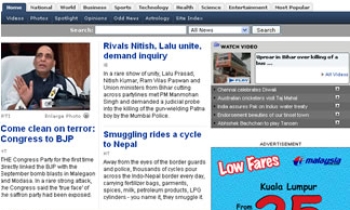The decline in newspaper circulation figures and the tepid growth of subscription, single copy purchase, and advertising revenues between 2005 and 2009 is a global phenomenon, says PricewaterhouseCoopers’ Global Entertainment and Media Outlook: 2005-2009. No matter where in the world the newspaper business is located, the story repeats itself.
The Outlook defines the newspaper publishing market as consisting of spending by advertisers and readers on daily print newspapers, including both newsstand purchases and subscriptions. Community and other weekly papers are not included. Similarly, online subscriptions are not included. The advertising generated through online editions and online classifieds are accounted for in the Internet Advertising and Access Spending chapter of the Outlook.
In the U.S., newspaper revenue will grow at a relatively slow 3.3 percent compound annual growth rate (CAGR) compared to other entertainment and media segments. A study reported in the Outlook audited 50 of the top newspapers, finding that subscriptions fell 2.5 percent for the September 30, 2004, six-month audit period, and single copy purchase declined 6.8 percent. Similarly, in Europe, the Middle East, and Africa (EMEA), newspapers will increase revenues by a 3 percent CAGR, but will face a year-to-year circulation decline from about 96 million in 2004 to 91.8 million in 2009, a -0.9 percent CAGR.
Asia/Pacific is the fastest-growing region for newspapers, with revenues increasing at a 3.7 percent CAGR during 2005-2009. Circulation is a brighter spot in the People’s Republic of China and India; their combined circulation will rise from about 165 million in 2005 to 188 million in 2006. Circulation in the rest of the region will decline slightly.
In both Latin America and Canada, newspaper revenue will expand at a 2.8 percent CAGR, but circulation will continue to fall.
New technology bytes
The Internet has had an impact on the all media channels, including the television and magazine publishing industries. But it has had even more profound effects on the newspaper industry. It undercuts newspapers’ revenue sources: Instead of subscription and purchase, people are turning to the Net or TV for up-to-the-nanosecond news. They tend to go online to research products and compare prices from multiple retailers instead of reading newspapers’ display ads. And they are listing items for sale and looking for items to buy on electronic counterparts of the classifieds section. In areas where two-way digital television becomes a force, it too is likely to cause consumer usage of newspapers to decline.
In the U.S., the consolidation of retailing has had a negative effect on advertising. The "big box" retailers have adopted a media mix that targets more of their advertising budget to the Internet. However, disappointing sales at those retailers during the fourth quarter of 2004 may result in more dollars spent for newspaper ads next year.
Everywhere, the emergence of free daily papers is undercutting revenues and circulation of subscription and single copy purchase newspapers. While free papers often appeal to a young demographic who might not be paid subscribers to established newspapers, they still take away advertising and classified ad dollars.
Moving the deck chairs
Despite the challenges facing the industry around the world, newspaper publishers are taking steps to mitigate their difficulties. In the U.S. they have promoted sponsored circulation, where advertisers pick up 25 percent of the subscription costs to reach newspaper readers. They are also adding special weekend editions and Sunday magazine supplements, which encourage readership. Without these efforts, the circulation decline would have been even larger.
In EMEA and Asia/Pacific, publishers are adapting tactics to reach their audiences. Some publications have changed to easier-to-read and handle tabloid formats. Research in the UK found that papers that made the change experienced moderate increases in circulation, compared to publications that did not change formats.
New technology may even be of help. Some publishers are taking advantage of the popularity of Short Message Service (SMS) text messaging in EMEA and Asia/Pacific, using it to update articles throughout the day. They market the service to their subscribers to bring in an additional revenue stream.









